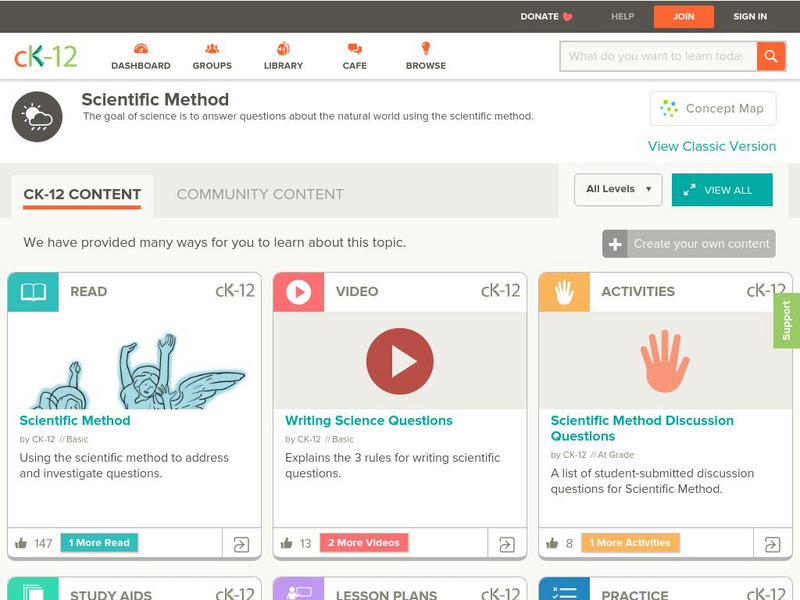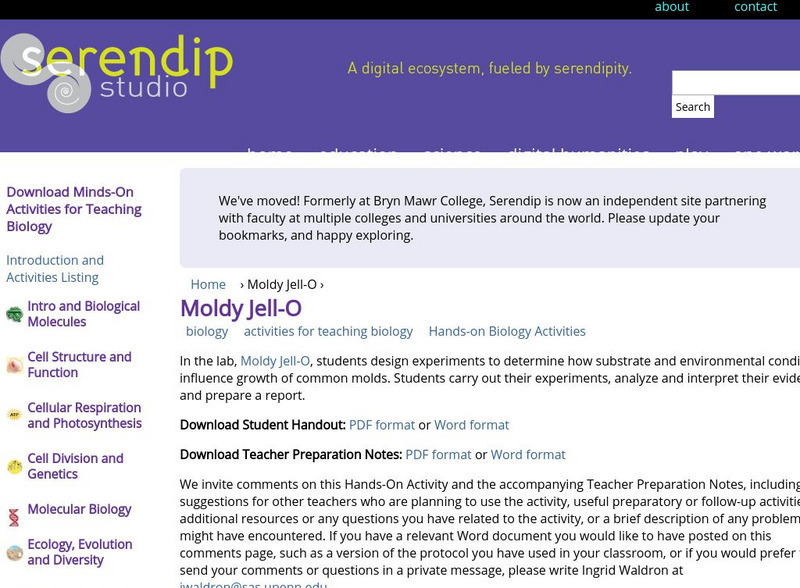University of Washington
Washington U: Model for Conducting Scientific Research
This page outlines the scientific method, step by step.
CK-12 Foundation
Ck 12: Scientific Method
[Free Registration/Login may be required to access all resource tools.] Instructional videos, grade-level texts, interactive activities, and review material about the scientific method.
ReadWriteThink
Read Write Think: Digging Up Details on Worms: Using Science in an Inquiry Study
A lesson plan based on a study unit of earthworms, using the inquiry model to integrate scientific processes with literacy practices. Instruction plans, related resources, and standards are included.
Science Education Resource Center at Carleton College
Serc: Scientific Observation Activity
For this structured exercise, young scholars are asked to observe the world around them and make an observation about any sort of process they see. They then ask a how or why question about their observation, and follow that by three or...
Climate Literacy
Clean: Time Series: Uncovering the Hidden Processes in Science
In the following exercise, students will review techniques useful to scientists asthey analyze series of data. Learn about scientific observation and try to recognize a pattern or trend within the data.
Science Education Resource Center at Carleton College
Serc: A Data Rich Exercise for Discovering Plate Boundary Processes
This article in the Journal of Geoscience Education describes a classroom exercise based on four world maps containing earthquake, volcano, topographical and seafloor age data. Young scholars participate in this exercise by using a...
National Center for Ecological Analysis and Synthesis, University of California Santa Barbara
Kids Do Ecology: Data and Science
Learn about conducting your own investigation with these tips on following the scientific method. Find out how to state hypothesis, make observations, collect and analyze data, and display data to share results and conclusions of your...
TeachEngineering
Teach Engineering: Students as Scientists
This curricular unit contains two lessons that let students actually do the work of scientists as they design their own experiments to answer questions they generate. In the first lesson and its associated activity, students conduct a...
TeachEngineering
Teach Engineering: Corn for Fuel?!
In this activity, students examine how to grow plants the most efficiently. They imagine that they are designing a biofuels production facility and need to know how to efficiently grow plants to use in this facility. As a means of...
Globe
The Globe Program: The Mystery of the Missing Hummingbirds [Pdf]
This story is an interesting way to help students understand the process of migration. It provides teachers with information on how to approach a particular lesson and its easy-to-read content is easily adaptable for grades K-12.
Science Education Resource Center at Carleton College
Serc: Mn Step: You Are a Scientist
Learners will practice the scientific method as they observe nature and ask questions about it.
Bryn Mawr College
Serendip: Moldy Jell O
Brief text summary of what students learn in the Moldy Jell-O Lab along with links to download Student Handouts and Teacher Preparation Notes in PDF or Word formats. Students design the experiment and observe the growth of mold. Focus is...
Scholastic
Scholastic: Keep Your Own Field Journal
This site, which offers templates for field journals, is part of a larger, interdisciplinary site about New Zealand. Walks you through the process and purpose of a field journal for scientific observation.
McREL International
Mc Rel: Glue Polymer (Whelmer #15 Learning Activity)
An easy to do activity that investigates the basic principles behind chemical bonding. The activity is written in lesson plan format that meets NSES standards.
McREL International
Mc Rel: Whelmer #64 Learning Activity: Liquid Rainbow
An easy to do activity that investigates density and solubility. The activity is presented in lesson plan format that meets NSES standards.











